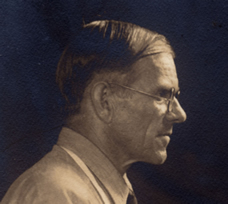The People:
Park Fisher

Park Fisher (1880-1959) was a friend of John C. Campbell’s and remained in touch with Olive Campbell after John’s death. Fisher taught at the John C. Campbell Folk School in the 1930s; he was the school’s first woodworking teacher. Little is known about Fisher. He is listed in the October 1930 John C. Campbell Folk School newsletter and, again, in an Asheville Citizen newspaper article four years later. Other than these few brief references and a number of photographs, little was recorded on Fisher’s work at the folk school. A photograph of a dulcimer that Fisher made with musician John Jacob Niles is pictured in Allen Eaton’s 1937 Handicrafts of the Southern Highlands.
A native of Harlan, Iowa, Park Fisher was born in 1880 in a building that served as his father’s photography studio. A childhood accident left him disabled; he walked with crutches for the rest of his life. According to Olive Dame Campbell, Fisher graduated from the Atlanta Theological Seminary and Hartford Theological Seminary and served as a minister in the Congregationalist church. A memorial recalling Fisher’s life states that he lived in Georgia for 20 years and in Kentucky for 10, before moving to North Carolina. Wherever he lived, Fisher served as a preacher and missionary; he taught woodworking and gun repairing as well. Fisher knew Olive Campbell through her husband, John. The two men met in Demorest, Georgia, where John Campbell taught at Piedmont College. Although little is known of the two men’s relationship in Georgia, Campbell did write a letter of recommendation for Fisher, calling him an “all around handy man.” In a biography of her husband, Olive Campbell called Fisher an “old friend.” 1
In 1925, Olive Campbell established the John C. Campbell Folk School to honor her late husband’s work with the people of the southern Appalachians. Initially, the school did not include crafts instruction, but the formation of several local cooperatives included a Handicraft Guild in 1929. Craftwork took firm root at the folk school during the summer of 1930, when the school held its first ten-day, summer “short course.” Margaret Campbell (no relation to John or Olive), a teacher at the Pleasant Hill Academy in east Tennessee, taught carving as a guest instructor during this first summer session. Park Fisher directed the boys in making tool chests. Soon afterward, woodcarving began to take root at the school. In 1930, Fisher’s name was included in the school newsletter as an instructor in woodworking as one of three teachers along with Louise Pitman and Jane Chase. 2
While no further mention of Fisher is made in the folk school’s newsletters, in a 1932 Annual Report to its Board of Directors, Olive Campbell noted that,
The last few weeks have seen a real interest from the boys in carving, for the most part of farm animals. Frequently geese or donkeys make their appearance at meal time and necks or hind-quarters are compared as to beauty of line or resemblance to the original. 3
This was before the school hired its long-time carving instructor, Murrial Galt Martin, so it is likely that the woodcarving activity was supervised by Fisher at this time. By 1933 there were 20 steady workers supplying the craft “industries.” Student carver Hayden Hensley supported his family with income derived from carving.
While Martin is often cited as the founder of the school’s carving program, its structure seems to have been in place before she arrived. In the next year’s Annual Report, Campbell explained how the Brasstown carvers cooperative functioned:
The carving was done in the home and brought to the school where it is inspected for quality of craftsmanship and perfection of line and form. It is then finished and marketed by the School. 4
In 1933, Allen Eaton organized a regional crafts exhibition that traveled to a number of sites throughout the eastern United States. John C. Campbell Folk School was well represented. Twenty carved animals were part of the exhibit, including a “mad mule,” a motif initiated by brothers, Ben, John, and Elisha Hall. When the exhibition, Mountain Handicrafts, opened in Washington, DC, it caught the attention of President and First Lady Roosevelt. There are several newspaper accounts of Mrs. Roosevelt purchasing items from the exhibit, and at least one article from the Asheville Citizen newspaper that mentions Park Fisher. A photograph of four dulcimers appeared in Eaton’s Handicrafts of the Southern Highlands; the large one on the right was made by musician John Jacob Niles and Park Fisher. 5
- M. Anna Fariello, 2008
1. W. Douglas Fisher, “IN MEMORIAM: The Reverend Parker W. Fisher,” http://archiver.rootsweb.ancestry.com/th/read/KY-KNOTTHISSOC/2003-09/1064490296, accessed August 27, 2008.
Olive Dame Campbell, The Life and Work of John Charles Campbell: September 15, 1868 to May 2, 1919 (Madison, Wisconson: Privately printed, 1968) 556-557. In Campbell’s account, Fisher’s disability was due to his having polio as a child.
2. John C. Campbell Folk School 10 [school newsletter] (Oct. 1930).
3. [John C. Campbell Folk School Annual Report] 1932, 8 -10.
4. [John C. Campbell Folk School Annual Report] 1933, 13.
5. American Federation of Arts, A Catalogue of Mountain Handicrafts by the Members of the Southern Highland Handicraft Guild (New York: American Federation of Arts, 1933) 15. “President Roosevelt Expresses Interest in Craft Work, Wood Carvings Occupy Places in White House,” Asheville Citizen, April 8, 1934. Allen Eaton, Handicrafts of the Southern Highlands (New York: Russell Sage, 1937) 204, 242; the photograph was mistakenly printed in reverse in Eaton’s book.


 copy.jpg)



